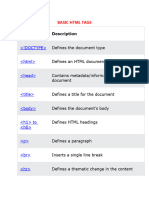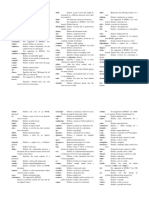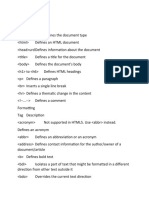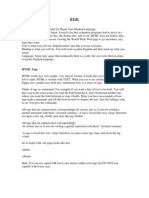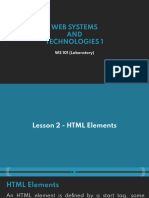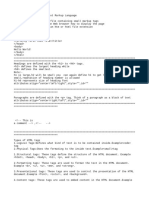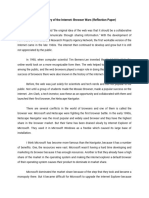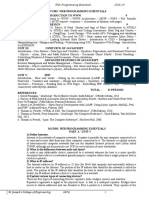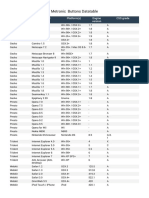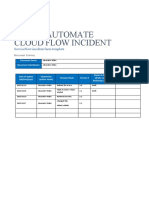Comprehensive HTML Tags Reference
1 Introduction
HTML (HyperText Markup Language) is the standard language for creating web
pages. Below is a comprehensive list of HTML tags along with their descriptions.
2 Basic Structure Tags
• <!DOCTYPE html> - Defines the document type and version of HTML.
• <html> - The root element of an HTML page.
• <head> - Contains metadata, links to stylesheets, and scripts.
• <title> - Defines the title of the document (shown in the browser tab).
• <body> - Contains the content of the webpage.
• <meta> - Provides metadata about the document (character set, viewport,
etc.).
• <link> - Links external resources such as CSS files.
• <script> - Embeds JavaScript code.
• <noscript> - Defines content to be shown if JavaScript is disabled.
3 Text Formatting Tags
• <h1> to <h6> - Heading tags, where <h1> is the largest and <h6> is the
smallest.
• <p> - Defines a paragraph.
• <b> - Makes text bold.
• <strong> - Represents important text (bold).
• <i> - Makes text italic.
• <em> - Represents emphasized text (italic).
1
� • <u> - Underlines text.
• <mark> - Highlights text.
• <small> - Displays smaller text.
• <del> - Displays deleted text (strikethrough).
• <ins> - Displays inserted text (underlined).
• <sub> - Displays subscript text.
• <sup> - Displays superscript text.
• <br> - Inserts a line break.
• <hr> - Inserts a horizontal line.
• <pre> - Displays preformatted text.
• <code> - Defines a piece of computer code.
• <kbd> - Represents keyboard input.
• <samp> - Represents sample output from a computer program.
4 Links and Media
• <a href="URL"> - Creates a hyperlink.
• <img src="URL" alt="description"> - Displays an image.
• <audio controls> - Embeds an audio file with playback controls.
• <video controls> - Embeds a video file with playback controls.
• <source> - Specifies media sources inside <audio> or <video>.
• <iframe> - Embeds another webpage or media content.
• <embed> - Embeds external applications (like PDFs or Flash).
• <object> - Embeds an external object, such as multimedia.
2
�5 Lists
• <ul> - Defines an unordered list (bulleted list).
• <ol> - Defines an ordered list (numbered list).
• <li> - Defines a list item inside <ul> or <ol>.
• <dl> - Defines a description list.
• <dt> - Defines a term in a description list.
• <dd> - Defines a description of a term in a description list.
6 Tables
• <table> - Defines a table.
• <tr> - Defines a table row.
• <td> - Defines a table cell (data).
• <th> - Defines a table header cell.
• <thead> - Groups the header content in a table.
• <tbody> - Groups the body content in a table.
• <tfoot> - Groups the footer content in a table.
• <caption> - Defines a table caption.
• <colgroup> - Specifies a group of columns in a table.
• <col> - Specifies column properties for each column within a <colgroup>.
7 Forms and Input Elements
• <form> - Defines a form.
• <input> - Defines an input field (text, password, radio, checkbox, etc.).
• <label> - Labels an input field.
• <textarea> - Defines a multi-line text input.
• <button> - Creates a clickable button.
• <select> - Creates a dropdown list.
• <option> - Defines an option in a dropdown list.
• <fieldset> - Groups related input fields in a form.
• <legend> - Defines a title for a <fieldset>.
3
�8 Div and Span
• <div> - A block-level container used for grouping elements.
• <span> - An inline container used for styling parts of text.
9 Semantic Elements
• <header> - Represents the header section of a page.
• <nav> - Represents navigation links.
• <section> - Defines a section in a document.
• <article> - Represents an independent piece of content.
• <aside> - Represents sidebar content.
• <footer> - Represents the footer section of a page.
• <main> - Represents the main content of the document.
• <figure> - Groups media content with captions.
• <figcaption> - Provides a caption for a figure.
10 Conclusion
This document covers a broad set of essential HTML tags useful for structuring,
formatting, and enhancing web pages.



















